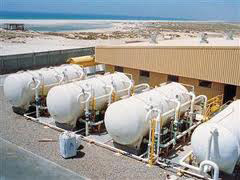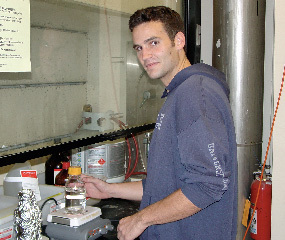
A paper co-authored by William Phillip of the University of Notre Dame’s Department of Chemical and Biomolecular Engineering and Menachem Elimelech, Robert Goizueta Professor of Environmental and Chemical Engineering at Yale University, appearing in this week’s edition of the journal Science offers a critical review of the state of seawater desalination technology.
Elimelech and Phillip and examine how seawater desalination technology has advanced over the past 30 years, in what ways the state-of-the-art technology can be improved, and if seawater desalination is a sustainable technological solution to global water shortages.
“At present, one-third of the world’s population lives in water stressed countries," Phillip said. “Increasing population, contamination of fresh water sources and climate change will cause this percentage to increase over the coming decade. Additionally, the social and ecological benefits of adequate fresh water resources are well-documented. Therefore, it is important to find a way to alleviate this stress with a sustainable solution.”
The authors point out that in recent years, large-scale seawater desalination plants have been built in water-stressed countries to augment available water resources and construction of new desalination plants is expected to increase in the near future. Despite major advancements in desalination technologies, seawater desalination is still more energy intensive compared to conventional technologies for the treatment of fresh water. There are also concerns about the potential environmental impacts of large-scale seawater desalination plants.
In their Science paper, Elimelech and Phillip review the possible reductions in energy demand by state-of-the-art desalination technologies, the potential role of advanced materials and innovative technologies in improving the performance, and the sustainability of desalination as a technological solution to global water shortages.
The authors believe that there are important policy implications in their Science paper.
“Seawater desalination is an energy-intensive process; desalinating seawater consumes significantly more energy than treating traditional fresh water sources,” Phillip said. “However, these traditional sources aren’t going to be able to meet the growing demand for water worldwide. Several options already exist to augment fresh water sources — including the treatment of low-quality local water sources, water recycling and reuse and water conservation — and understanding where seawater desalination fits into this portfolio of water supply options is critical. Hopefully, our paper helps provide some of the information needed to inform the decisions of policy makers, water resource planners, scientists, and engineers on the suitability of desalination as a means to meet the increasing demands for water.”

Phillip, who joined the Notre Dame faculty this year, is interested in examining how membrane structure and chemistry affect the transport of chemicals across a variety of membranes. Understanding the connection between functionality and property enables the design and fabrication of next generation membranes that provide more precise control over the transport of chemical species. These material advantages can be leveraged to design more effective and energy-efficient systems. Chemical separations at the water- energy nexus (e.g., desalination) is one area where this knowledge can be applied.
Contact: William Phillip, 952-393-5162, wphillip@nd.edu